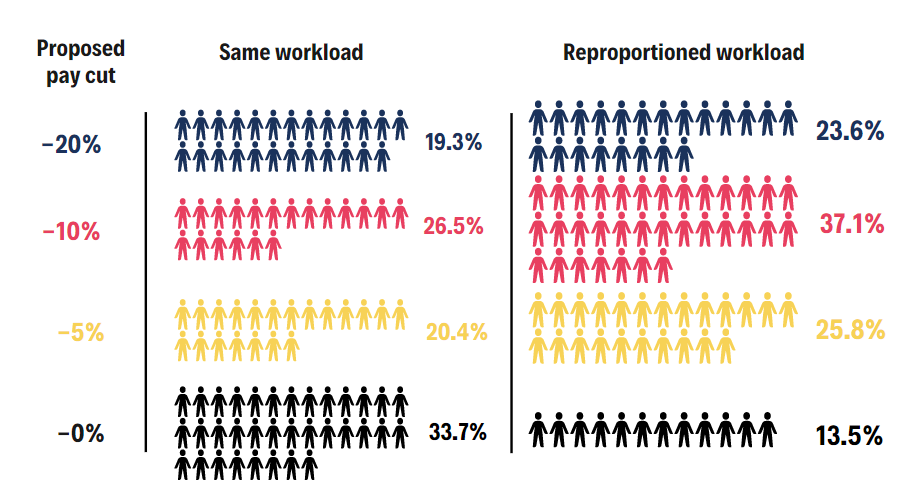Work is a fundamental part of the life of an individual. If we think that the average person spends 90.000 hours at work, a third of their life, we can understand why money can’t be considered the only driver for a worker.
The last two years of the pandemic made it clearer than ever: the resignation boom that began in 2021, called the Great Resignation, has highlighted the needs of a society that has changed its priorities and seeks a deeper meaning that goes beyond the monetary value of time. This phenomenon involves all generations, in fact there have been strong increases in the rates of resignations for employees in the age group 30-35 (21.5%), 35-40 (19.6%) and 40-45 (25.1%). In Italy, the youngest are leading the trend, with the 26-35 age group accounting for 70% of the resignations recorded during the pandemic. As a society, the discussion about workplace wellness is becoming more urgent. However, initiatives aimed at balancing the needs of workers and firms are not new. One particularly promising approach is the four-day workweek.
Reducing working hours: an innovation from the past
The current 40-hour workweek structure may seem like an indisputable element of our work system, but it is actually a relatively recent invention. It was, in fact, after the Industrial Revolution that it became popular among firms, and one of the most important promoters was Henry Ford.
The Ford Motor Company established the initiative in 1914, scaling from a 48-hour to a 40-hour workweek. The reason was that Mr. Ford believed that too many hours negatively affected worker productivity – a right intuition, as today the same argument is used by estimators of the four-day workweek, after being proven correct by many papers.
The four-day workweek can be applied in many ways, but the most common is to work 8 hours a day for four days, for a total of 32 hours per week. In a paper from Birkbeck University of London, Professor Pedro Gomes reported some of the positive (theoretical) effects attributed to the four-day workweek, such as the increase in leisure consumption and stimulation of innovation. Other sources suggest improvements in mental and physical health, a lower carbon footprint, fewer absences, and better employer retention.
Utopia or reality?
Some countries and companies have already started experimenting with the four-day workweek. One of the most notorious cases is the Microsoft experiment. The Japanese branch of the firm implemented the four-day workweek in August 2019 and the results were impressive: productivity increased by almost 40% compared to August 2018, electricity consumption went down by 23% and 92% of employees rated the short week positively.
Another successful example is the Iceland case study. The city of Reykjavik implemented a 36-hour workweek during two trials, in 2015 and 2017. The experiment involved more than 1% of Iceland’s working population. Productivity has either improved or been unaffected: the key to success were shorter meetings and fewer moments of distractions, such as coffee breaks and water cooler chats. At the same time, business and government spending did not increase. Employees reported feeling less stressed, experiencing a better work-life balance and having more time to spend with family. The report also suggests an improvement in gender equality, as male respondents in a heterosexual relationship claimed to take “a greater role in home duties after the trial started”. Today 86% of Iceland working population has reduced working hours.

Source: A 4-day workweek is the norm in Iceland. Could the U.S. follow? (cnbc.com)
At the forefront of the four-day movement is 4 Day Week Global, an organization founded by Andrew Barnes and Charlotte Lockhart, which aims to promote the spread of the four-day workweek. The association has launched numerous pilot programs around the world: 30 companies in the UK and 38 companies in the US and Canada are currently experimenting the short workweek over a 6 months period. Meanwhile, other countries have taken initiatives on their own. One of the most recent is Spain, where the government invested 50 million euros in a project to apply the four-day workweek in 200 companies for three years. However, the project start date has yet to be announced.
An experiment by SteamGreen
The four-day workweek certainly seems like an appealing alternative to the current working system, but at the same time it still lacks scientific validation and involves some major challenges.
The SteamGreen team decided to investigate people’s thoughts and feelings about the four-day workweek, analysing the value of free time for workers. To do this, we asked people if they were willing to cut their salary (and by how much) if they were given the chance to work 32 hours a week in 4 days. They were asked to consider first the hypothesis of a wage reduction while maintaining the same workload, and then the hypothesis of a wage reduction with a re-proportioned workload.
Through a questionnaire we collected the answers of 128 respondents from Italy. From the survey we were able to draw some interesting food for thought.
1. People who work more are more stressed.
We asked people about their feeling about their current working conditions. As expected, people who say they are often or always stressed and think they work too many hours, on average work 42 hours a week for 5.2 days. On the other hand, people who are never, rarely or sometimes stressed and usually think they don’t work too many hours, work an average of 32.8 hours per week for less than 5 days (4.73).
This may seem like a trivial result but, as the scientific method teaches us, knowing something is not the same as proving it. The fact that the data indicates that there is a relationship between working time and the wellbeing of workers is relevant.
2. The amount of workload is a very influential element in the implementation of the four-day workweek.
We asked people if they were willing to cut their salary (and by how much) if they were given the possibility to work 32 hours for 4 days a week. They were asked to consider first a wage reduction with the same workload and then a wage reduction with reproportioned workload. They had the option of choosing a salary reduction of 20%, 10%, 5% or 0%.
Maintaining the same workload, the largest share (33.7%) of respondents refused any salary reduction option, while the second largest share (26.5%) chose a 10% pay cut.
Re-proportioning the workload, the largest share (37.1%) accepted a 10% pay cut. Only 13.5% of respondents refused any pay cut.

3. According to most of the respondents, productivity, wellbeing, stress and relationship with colleagues would improve significantly with a four-day workweek with a reproportioned workload.
When interviewees were asked to consider a four-day workweek with the same workload the responses were much less enthusiastic.
4. Employees are skeptical about the implementation of the four-day workweek.
33% of respondents think their company is capable of implementing the four-day workweek, but only 5.4% of respondents think their company would be willing to do so.
5. Older respondents (age groups 36-50 and 51+) are more likely to accept a larger wage reduction.
67% and 66% of respondents over the age of 35 accepted the offer of a 20% salary reduction for the same and the re-proportioned workload, respectively. The reasons could be that they have worked more years, so free time has a higher value for them, that they have other priorities (e.g., family), or that they have more economic wealth and therefore can more easily give up part of their salary.
6. The youngest respondents (age group 18-25) showed the most drastic difference between the wage reduction with same workload and re-proportioned workload.
41% of people in the younger age group refused any pay cut for a four-day workweek with the same workload. On the other hand, considering the same age group, the share of people who refused any salary reduction with a reproportioned workload dropped to 11%.
The reason may be that younger generations view work by objectives and not by hours. Consequently, they perceive the hypothesis of doing the same amount of work in less time not as an opportunity for more free time but as an “unfair” proposition.
The survey data has been analysed by our team through basic statistical tools. A more in-depth econometric analysis is necessary and desirable to avoid possible distortions. However, the results gave us interesting insights about the perception of the four-day workweek among workers and we hope that this project will stimulate interest in this topic.
To conclude, we must mention that the four-day workweek is not a panacea, as it still has many limitations and points to prove. Implementation, especially on a large scale, implies a mental and practical shift in society that would require a lot of time and resources. Nevertheless, we cannot fail to recognize the need for change that the current model needs and be ready to find alternatives suited to the new needs of a rapidly changing society.
Author’s note: the survey was created and administered by Alice Puglioli, Marta Gravina and Sofia Mazzon. If you would like more information about the survey and the data collected, please contact sofia.mazzon@studio.unibo.it
Cover picture by Tim Gouw via Unsplash.



